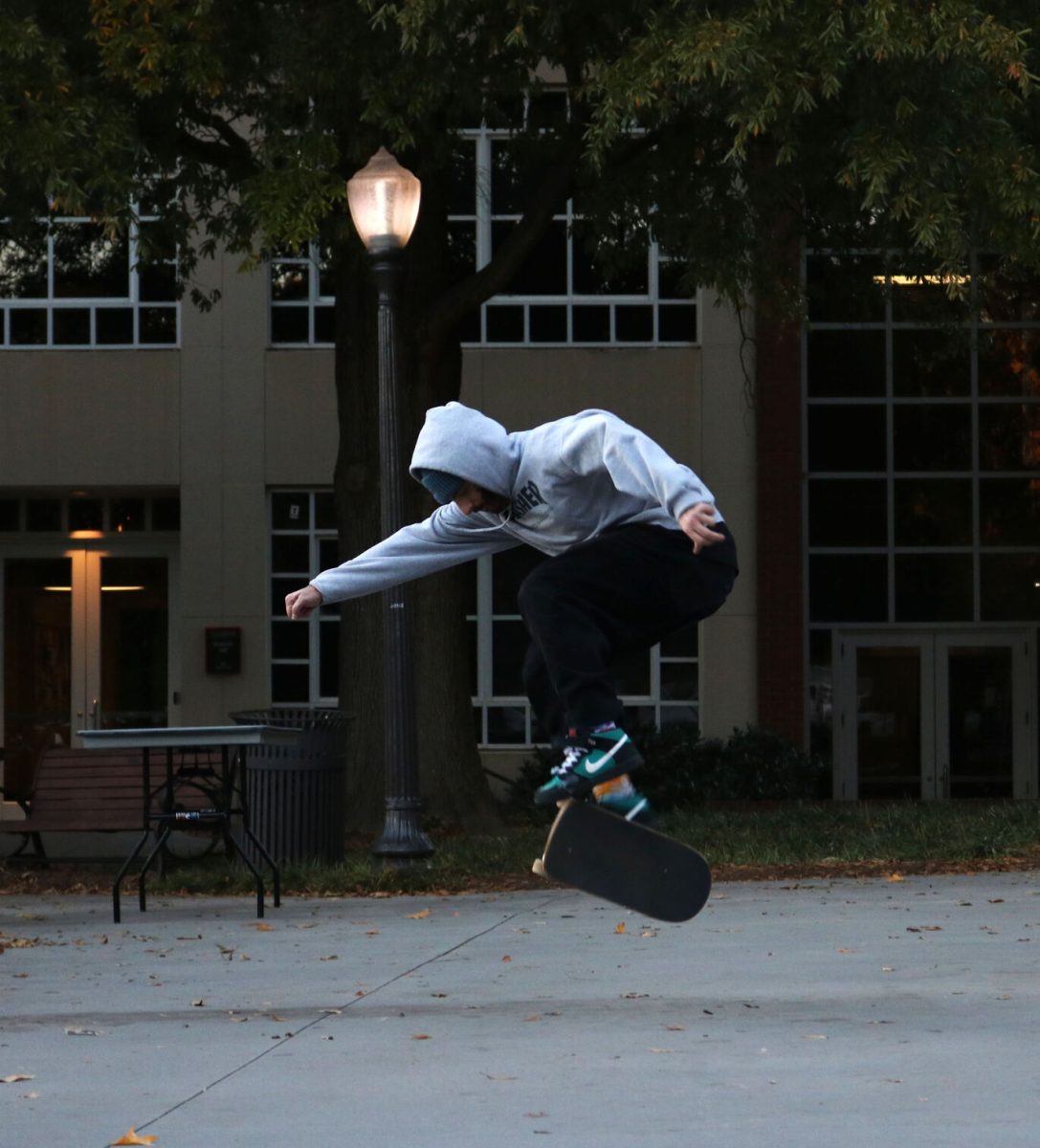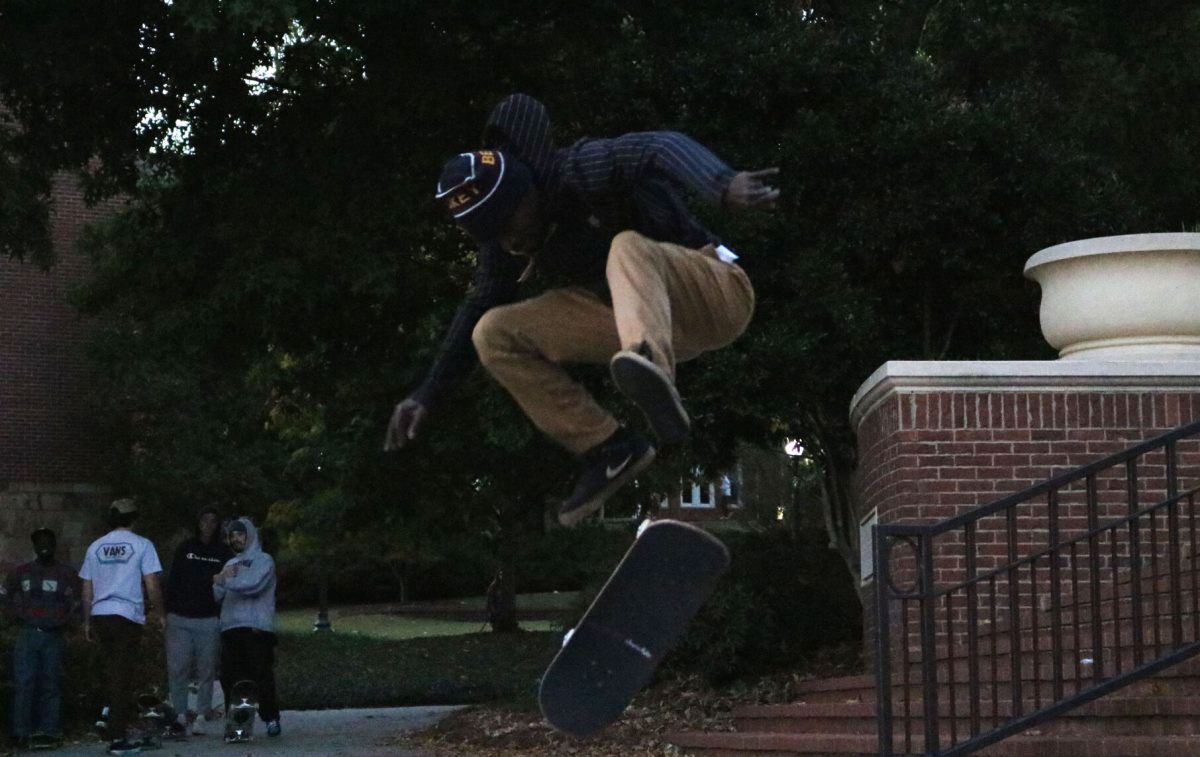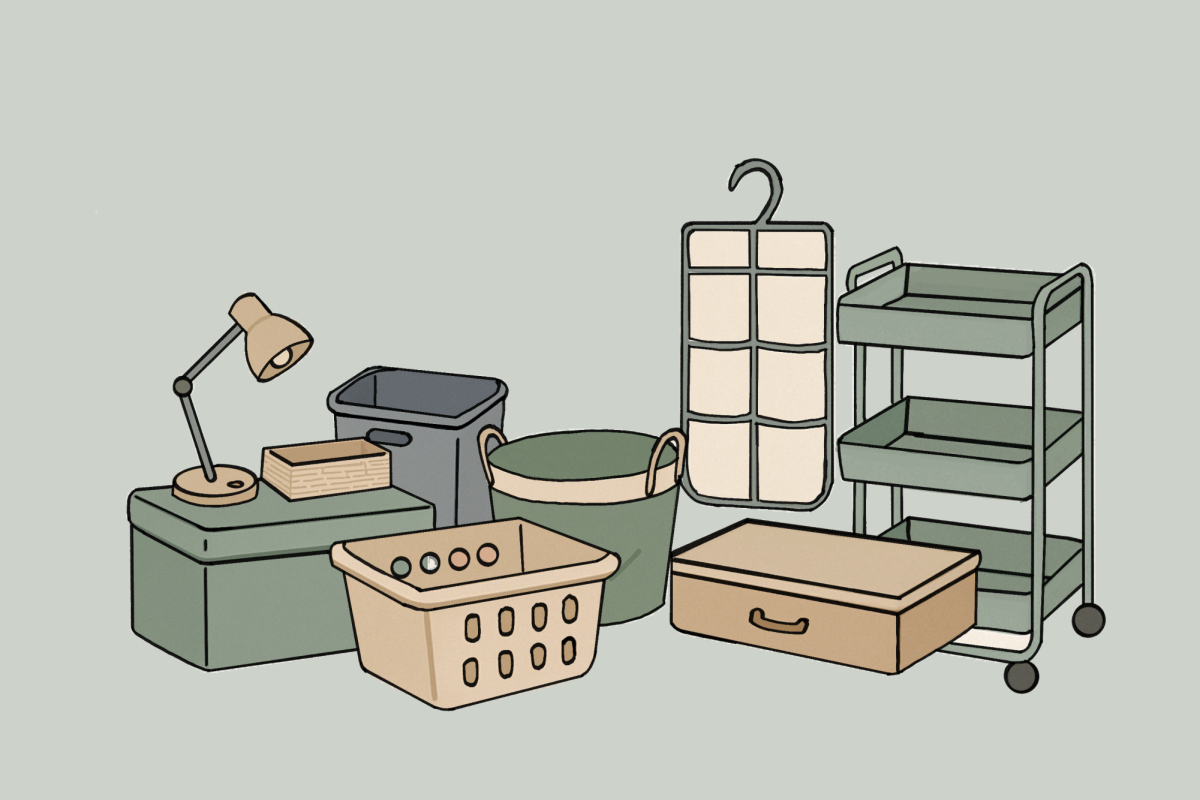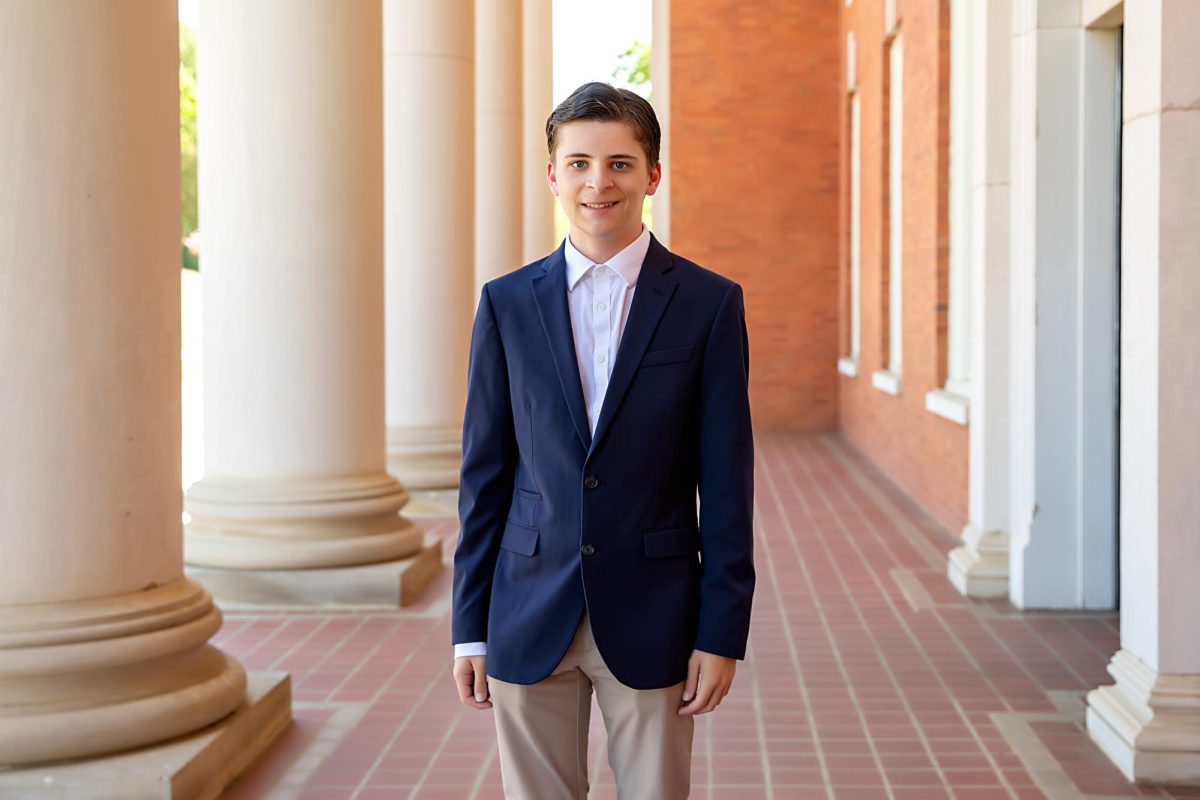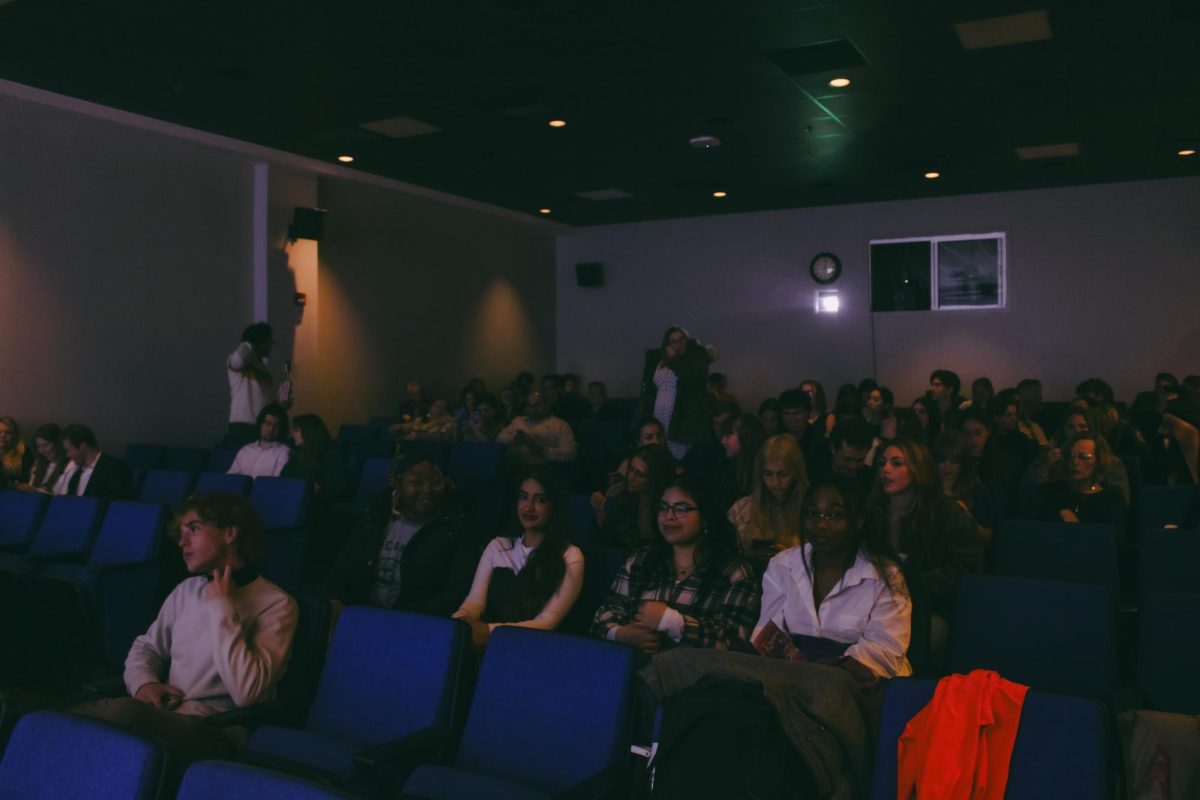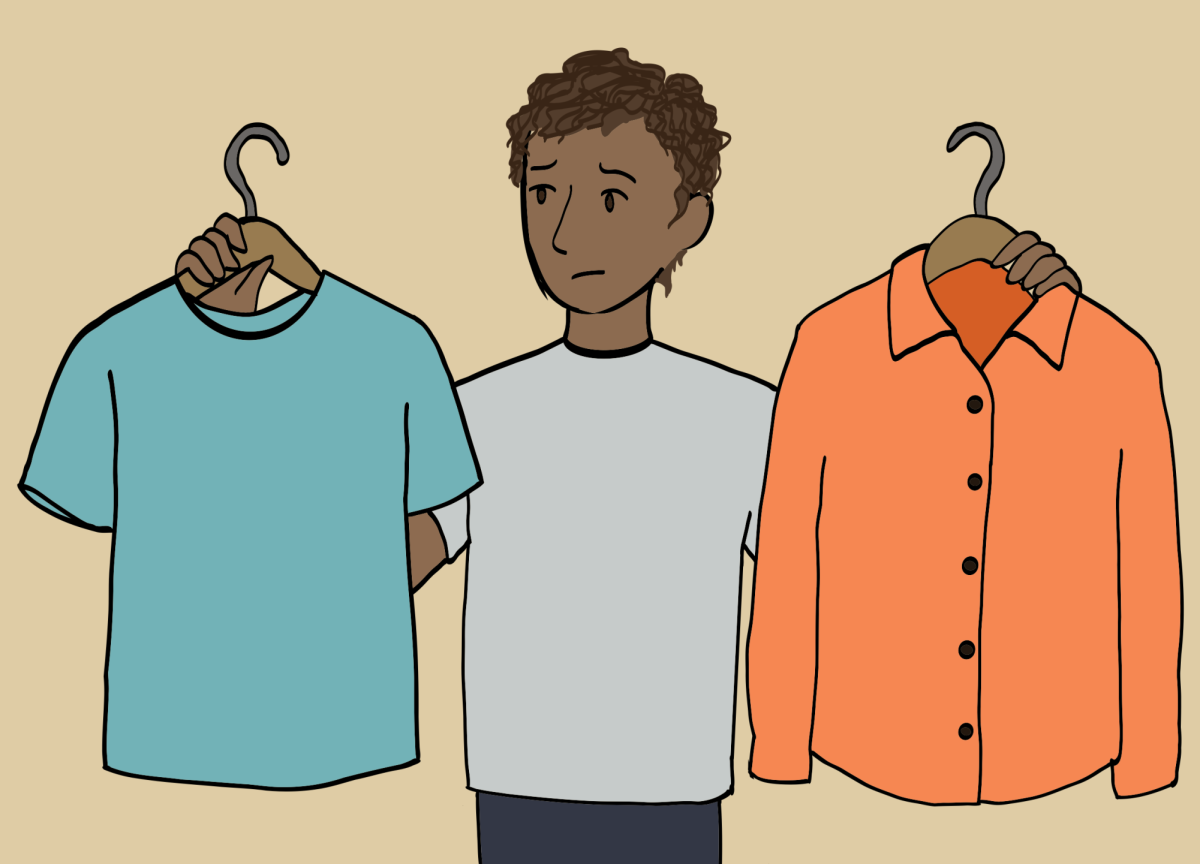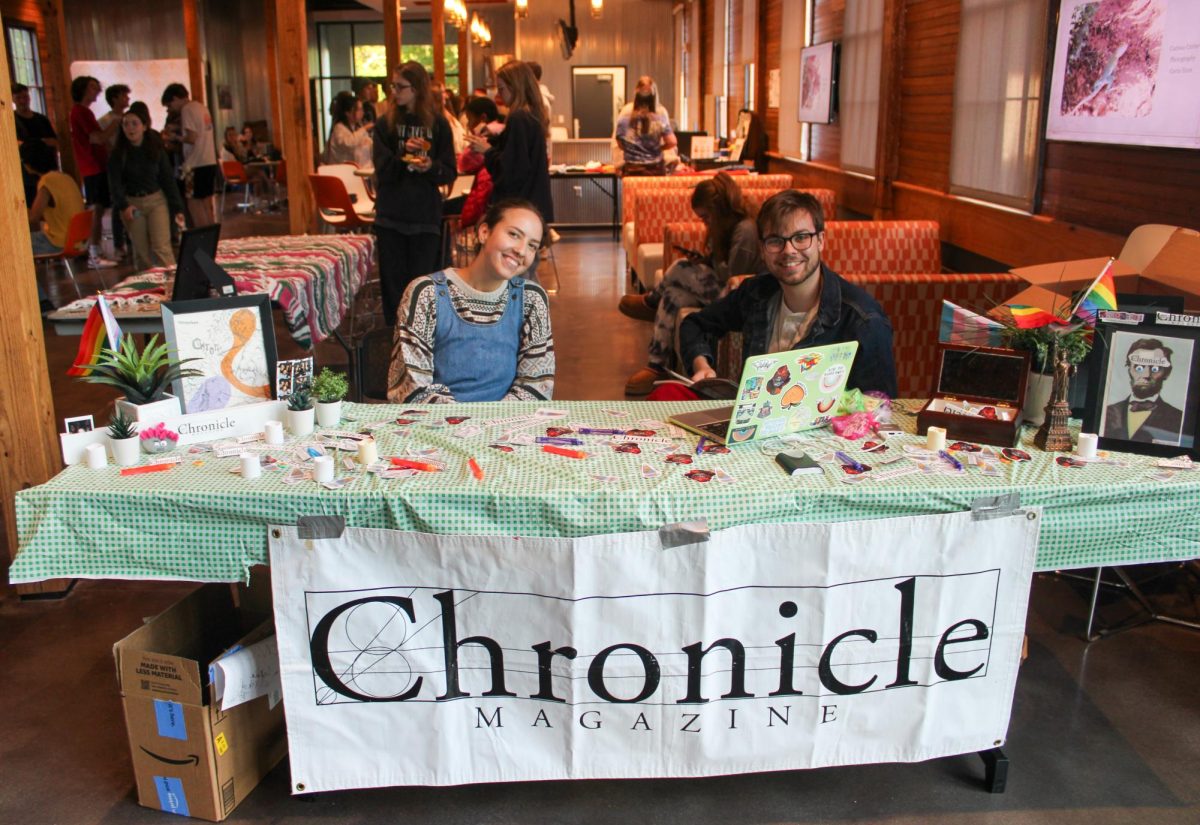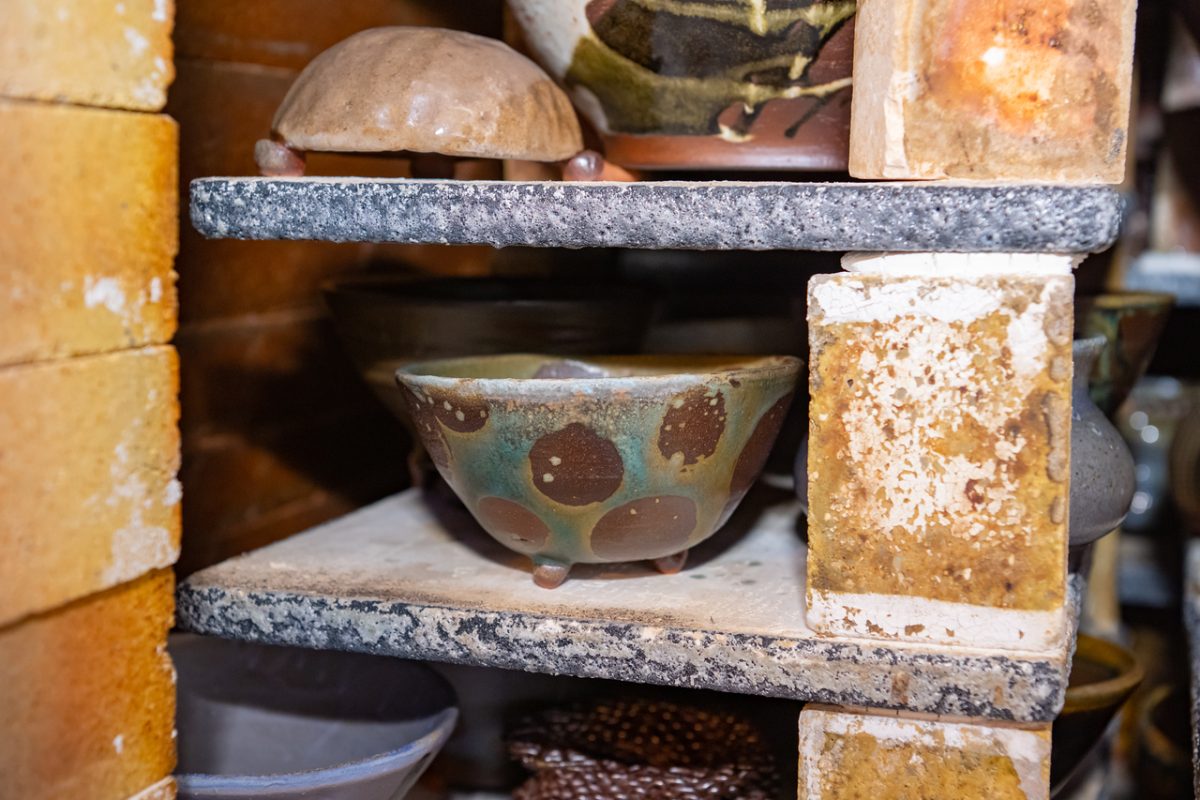Even from a distance I knew I was approaching them. The clatter of their wheels and skid of their decks. As I came closer, I saw five guys, all with skateboards.
Each had a similar style, comfortable clothing, all seemingly referencing an old school look or wearing a specific brand: Vans, New Balances, Adidas. They wear baggy pants or jeans, often with rips torn where they might have bailed off their board and fallen to the pavement to avoid a worse injury.
Despite this, they don’t usually wear helmets, knee pads or any typical safety equipment. Instead, they seem to face the risk of getting hurt head on.
At first, I just felt like a bystander, something that they are used to, part of the community watching them practice their tricks over and over. Observing eyes don’t seem to distract them from launching their boards towards a homemade obstacle called a box, passed down from a previous skater who graduated this past semester. The guys leaned on their boards beside a row of bushes, as they watched one skater drop his board to the pavement, get a running start and leap onto the deck, the name for the main part of the board where the skater’s feet sit. Their back foot slid to the end of the board while their dominant foot was used to flip it 360 degrees over the box, a maneuver called a kickflip.
They watched each others’ attempts and waited their turn. Some do ollies over the same obstacle, a trick where the skater launches themselves into the air with the board, like it’s stuck to their feet. It seemed like each trick could be a fight with the board, but also a simultaneous battle to be synchronous with it.
A freshman skater named Brandon (last names are being withheld for privacy of the skaters) lifted his baseball cap in surprise as he landed a trick without thinking after relentless attempts. The rest of the guys tapped the end of their boards on the pavement in applause. These tricks aren’t calculated or planned. In fact, none of this scene is. This is not a Clemson club or organization. This group of guys met through a hobby they can’t keep away from, their connections creating the skate culture of Clemson.
“It gave me a better sense of living, like a deeper sense of living,” Reggie, a skater who is a senior business management major at Clemson, said. “I felt like I thought on a surface level and then skating happened and all of these things happened because of skating, and, like, I think more deeply, I care more about the people around me.”
Clemson is not an ideal place for skateboarding, as the landscape isn’t flat. There aren’t any skate parks nearby, and oftentimes the police are called. Despite this, Brandon, Reggie and others have established a community with skating. Brandon said that even though the skate scene isn’t widely known about, making it somewhat exclusive, it is easy to become a part of. The skaters interviewed made it apparent that skating is essential to their livelihood and is responsible for many of the closest connections they have made while at Clemson.
Many of the guys started skating in the year of the COVID-19 pandemic, 2020, and others have been skating for many years before, or as soon as they could get their hands on a board.
“Skating around campus showed me campus,” Andrew, who came to Clemson in 2020, said.
Brandon said he met most of the guys in the scene through seeing them skate on campus, where they have most of their meetups. He may see someone’s deck, the underside often having a custom design and the top half covered in grip tape, which allows one’s feet to grip to the deck. Or he would watch someone land a trick and approach the new face to see if they ever do any street skating, a skating style that focuses on the urban environment and tricks having to do with feet movement.
“Skating, in a way, gave me a sense of purpose,” Reggie said. “Not because of skating itself but because of everything that came with it.”
Both Brandon and Reggie mentioned they rarely meet a skater over social media or in any other nonpersonal connection; usually they see them skate and see if they’d like to skate together. The guys said they only use Instagram group chats to stay in touch with each other and plan times to meet up. Other than this, the connections are organic.
“All these guys I’ve met, I didn’t meet them through a Clemson classroom, or anything like that, I met them by skating, and I think that’s important,” Reggie, a senior business management major, said. “Because it keeps that foundation: we are skaters, the skate culture is made by us, not made by Clemson.”
As someone who started skating in 2020, Reggie said that skating gave him an outlet and freedom from the constant stress in a world consumed by a pandemic. He said that coming out of the pandemic people have become more self-sufficient and this gave people a fresh way of thinking. For Reggie, during this time period especially, skating allowed for liberation not only in the way he skates, but in his social and academic life as well.
“Skating, in a way, gave me a sense of purpose,” Reggie said. “Not because of skating itself but because of everything that came with it. With skating you have to keep trying until you make a trick or keep going and going and going until it works out, that applies not just to this, but with everything in my life, I’ve noticed.”
In 2021, Reggie, his friend Nemiah, a Clemson graduate who now attends Harvard, and another friend, Asrin, also a recent graduate, started a skate collective known as Afterlyfe. The collective produces videos and social media post as well as clothing drops. This self-made brand has recently become an LLC as of 2022. Reggie emphasized his care for the content they produce and said people will understand the time it takes because they see it in the quality of the content. A lot of their digital media is made with old cameras that they find from thrift stores, through friends or family members. Reggie says that these vintage cameras give a consistent look to the videos they produce, as well as matches an old-school image referencing the 1990s that many of the guys model after. Fisheye lenses are typically used to capture closeup shots, Brandon said, while regular lenses are used for wider views of tricks.
Brandon explained that the ’90s represents the prime of skateboarding, cultivating a sense of inspiration and idolization for many of the guys. During the ’90s, many brands known today, such as Element and Supreme, were formed, and the modern shape of the skateboard was finalized. Brandon said the videography helps make the reward of landing a trick feel tangible. Another skater, Sam, said he doesn’t even post his videos and instead watches them as a sort of personal gratification.
Brandon said that social media apps like TikTok may have made skating communities difficult to join for people who really wanted to learn. Trending apps often result in posers, or people who claim to be proficient skaters and aren’t, while real beginners, or people who don’t claim to be proficient skaters and actually aren’t, become deterred. Brandon said that social trends allowed for easy access to skating for people who may have been intimidated to start skating before. He continued saying that popular trends probably pushed away skaters who only cared about the exclusivity of the underground scene instead of skating itself.
“Any pro that you talk to is going to be ecstatic to have a new person learning, no matter the age, why they’re skating, what style of skating they like,” Brandon said. “Skateboarding, especially when you ask the pros, is a community to build each other up and be creative and expressive.”
Brandon said it seems like TikTok trends have moved on, and now more than ever it is easy to start skating as long as one has the drive to keep getting up again and again. He likes skateboarding because it is self-reliant, unlike other sports. You can skate wherever and whenever you want, at any pace. Brandon said it is really rewarding for Clemson skaters specifically to find others who also skate here, considering the difficult landscape and smaller community.
“Skateboards being used for transportation are allowed on most campus sidewalks. However, acrobatic maneuvers, stunts, trick riding and speed runs are prohibited on campus,” according to the Clemson University Public Safety website.
The guys mentioned that they feel like the campus is probably aware that they skate and does make an effort to obstruct them with “skate stoppers,” which are metal pieces attached to railings and ledges. I observed the guys being respectful of the architecture and passing pedestrians, as they mostly focused on their maneuvers.
Brandon said that skating allows for him to appreciate the campus landscape more than he probably would if he wasn’t skating there. He continued saying that a part of being in an underground scene is the risk of hindrance from police being called or the architectural skate stoppers. But since they aren’t destroying property or hurting anyone, there isn’t anything inherently wrong with their street skating.
Skating for transportation has become popular on campus with the rise of electric skateboard machines and longboards, a board that has a longer and wider deck and is traditionally used for cruising longer distances. In an increase of this skating for transportation, there is a Clemson organized club, the Clemson Boarders Club. The skaters I talked to said their experience with the club felt less inclusive to the street skating and trick boarding that they practice, so they had to become their own sort of club and community.
Brandon said he tried reaching out to Clemson’s student affairs about building a skate park, possibly in the space of the abandoned dorms besides Core campus. He got no response. Reggie said he feels as if the university doesn’t care about skating and the students that make up this underground community.
“The skate scene at Clemson does not represent what Clemson looks like to the average person,” Reggie said, as Clemson’s image is largely focused on football culture and STEM programs. The skate scene curated by Reggie and his friends is not the average image that Clemson produces, but this traditional image is not representative of what it is like being at Clemson.
“If you’re on a tour of Clemson, a high school student trying to come to Clemson, seeing this aspect (the skate culture) as opposed to the normal school environment gives a better sense of what Clemson should be,” Reggie said. “I’m talking about diversity honestly, not just race, I’m talking about types of people.”
The community of the Clemson skate scene is overall positive, inclusive and “everyone is trying to build each other up” as Brandon said. He continued saying a scene like this can really be found anywhere one can skate and most of all, everyone supports each other and hopes for each other to succeed. The guys showed that skating is a lot more than the sport itself, but instead a mental commitment and tangible validation they achieve.
Clemson skater performs a kick flip over an obstacle.


